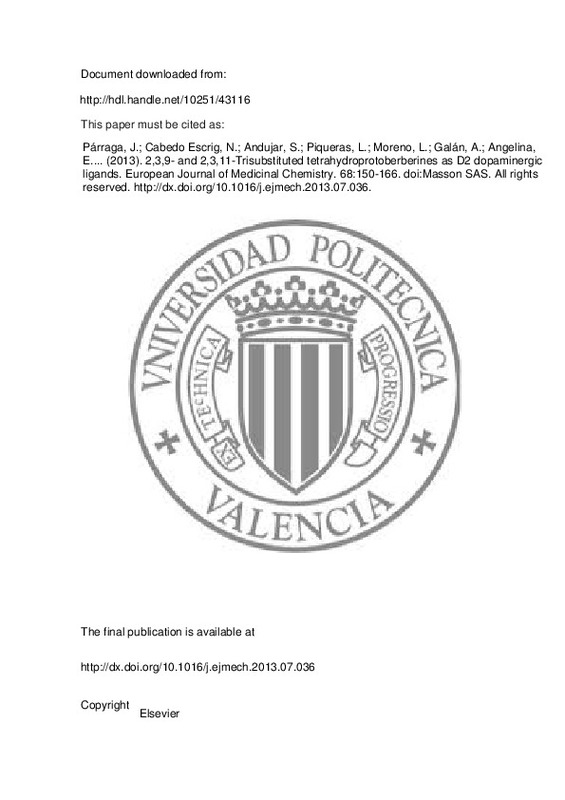Párraga, J.; Cabedo Escrig, N.; Andujar, S.; Piqueras, L.; Moreno, L.; Galán, A.; Angelina, E.... (2013). 2,3,9- and 2,3,11-Trisubstituted tetrahydroprotoberberines as D2 dopaminergic ligands. European Journal of Medicinal Chemistry. 68:150-166. https://doi.org/10.1016/j.ejmech.2013.07.036
Por favor, use este identificador para citar o enlazar este ítem: http://hdl.handle.net/10251/43116
|
Título:
|
2,3,9- and 2,3,11-Trisubstituted tetrahydroprotoberberines as D2 dopaminergic ligands
|
|
Autor:
|
Párraga, Javier
Cabedo Escrig, Nuria
Andujar, Sebastián
Piqueras, Laura
Moreno, Laura
Galán, Abraham
Angelina, Emilio
Enriz, Ricardo D.
Ivorra, María Dolores
Sanz, María Jesús
Cortes, Diego
|
|
Entidad UPV:
|
Universitat Politècnica de València. Centro de Ecología Química Agrícola - Centre d'Ecologia Química Agrícola
Universitat Politècnica de València. Instituto Agroforestal Mediterráneo - Institut Agroforestal Mediterrani
|
|
Fecha difusión:
|
|
|
Resumen:
|
Dopamine-mediated neurotransmission plays an important role in relevant psychiatric and neurological disorders. Nowadays, there is an enormous interest in the development of new dopamine receptors (DR) acting drugs as ...[+]
Dopamine-mediated neurotransmission plays an important role in relevant psychiatric and neurological disorders. Nowadays, there is an enormous interest in the development of new dopamine receptors (DR) acting drugs as potential new targets for the treatment of schizophrenia or Parkinson's disease. Previous studies have revealed that isoquinoline compounds such as tetrahydroisoquinolines (THIQs) and tetrahydroprotoberberines (THPBs) can behave as selective D-2 dopaminergic alkaloids since they share structural similarities with dopamine. In the present study we have synthesized eleven 2,3,9- and 2,3,11-trisubstituted THPB compounds (six of them are described for the first time) and evaluated their potential dopaminergic activity. Binding studies on rat striatal membranes were used to evaluate their affinity and selectivity towards D-1 and D-2 DR and establish the structure activity relationship (SAR) as dopaminergic agents. In general, all the tested THPBs with protected phenolic hydroxyls showed a lower affinity for D-1 and D-2 DR than their corresponding homologues with free hydroxyl groups. In previous studies in which dopaminergic affinity of 1-benzyl-THIQs (BTHIQs) was evaluated, the presence of a Cl into the A-ring resulted in increased affinity and selectivity towards D-2 DR. This is in contrast with the current study since the existence of a chlorine atom into the A-ring of the THPBs caused increased affinity for D-1 DR but dramatically reduced the selectivity for D-2 DR. An OH group in position 9 of the THPB (9f) resulted in a higher affinity for DR than its homologue with an OH group in position 11 (9e) (250 fold for D-2 DR). None of the compounds showed any cytotoxicity in freshly isolated human neutrophils. A molecular modelling study of three representative THPBs was carried out. The combination of MD simulations with DFT calculations provided a clear picture of the ligand binding interactions from a structural and energetic point of view. Therefore, it is likely that compound 9d (2,3,9-trihydroxy-THPB) behave as D-2 DR agonist since serine residues cluster are crucial for agonist binding and receptor activation.
[-]
|
|
Palabras clave:
|
Tetrahydroprotoberberines
,
Dopamine receptors
,
Structure-activity relationships cytotoxicity
,
MTT and cytofluorometric analysis
,
Theoretical calculations
|
|
Derechos de uso:
|
Reserva de todos los derechos
|
|
Fuente:
|
European Journal of Medicinal Chemistry. (issn:
0223-5234
)
|
|
DOI:
|
10.1016/j.ejmech.2013.07.036
|
|
Editorial:
|
Elsevier
|
|
Versión del editor:
|
http://dx.doi.org/10.1016/j.ejmech.2013.07.036
|
|
Código del Proyecto:
|
info:eu-repo/grantAgreement/MICINN//SAF2011-23777/ES/ESTUDIO DE LOS MECANISMOS MOLECULARES Y CELULARES EN LA DISFUNCION ENDOTELIAL ASOCIADA A ENFERMEDADES CON INFLAMACION SISTEMICA QUE PODRIAN INDUCIR DESORDENES CARDIOVASCULARES/
info:eu-repo/grantAgreement/MICINN//RD08%2F0075%2F0016/ES/RED DE INVESTIGACIÓN EN INFLAMACIÓN Y ENFERMEDADES REUMÁTICAS/
|
|
Agradecimientos:
|
This study was supported by grants SAF2011-23777, Spanish Ministry of Economy and Competitiveness, RIER RD08/0075/0016, Carlos III Health Institute, Spanish Ministry of Health and the European Regional Development Fund ...[+]
This study was supported by grants SAF2011-23777, Spanish Ministry of Economy and Competitiveness, RIER RD08/0075/0016, Carlos III Health Institute, Spanish Ministry of Health and the European Regional Development Fund (FEDER). R.D.E. and S.A.A. are staff members of the National Research Council of Argentina (CONICET-Argentina).
[-]
|
|
Tipo:
|
Artículo
|







![[Cerrado]](/themes/UPV/images/candado.png)

